
EASTERN TROPICAL PACIFIC

EASTERN TROPICAL PACIFIC
|
|
text & photos © Don Roberson
|

 |
The back of our cruise T-shirt is shown above. |
| We ran preplanned transects thousands of miles offshore, south of Hawaii
and west of the Galapagos, eventually reaching the Equator. We then turned
east past the Galapagos and into Costa Rica (port call; brief stop enroute
at Cocos I.) and then parallel to and below the Equator out another thousand
miles and back into Ecuador (port call). When a whale or group of dolphins
was spotted from the flying bridge (33 feet above sea level) by the mammal
observers on the 'big eyes,' we would turn the ship to approach the cetacean
for positive identification. When there were large ponds of dolphin, the
mammal observers entered their independent counts into their on-board
computers. [Bird observers also immediately entered all observations into
laptop computers during transects. We also looked for sea turtles.] When
the ship turned to chase down a cetacean, the bird observer was considered
"off effort" and could go to the bow for photos. Most of the photos on
this page were in those settings.
Here, we've spotted a Great Sperm Whale Physeter macrocephalus off the starboard bow, easily identified at a great distance by its slanted blow, canting off to the left. |
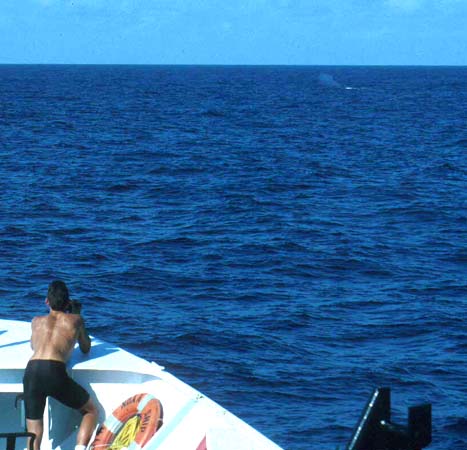 |
 The
two primary tuna-porpoise dolphins offshore are "spinners" and "spotters."
A mother and calf Eastern Spinner Dolphin Stenella longirostris
orientalis (left; this may be a different species than nominate Spinner
Dolphins elsewhere in tropical oceans) leap clear of the sea. This animal
occur in huge groups of hundreds, and often do remarkable spins during
theirs leaps. The
two primary tuna-porpoise dolphins offshore are "spinners" and "spotters."
A mother and calf Eastern Spinner Dolphin Stenella longirostris
orientalis (left; this may be a different species than nominate Spinner
Dolphins elsewhere in tropical oceans) leap clear of the sea. This animal
occur in huge groups of hundreds, and often do remarkable spins during
theirs leaps. |
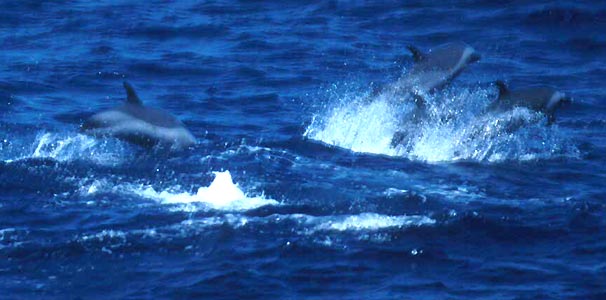 Pantropical
Spotted Dolphin Stenella attenuata (right) is quite variable.
Inshore populations are heavily spotted (hence the name) but offshore stocks
are not. There may be more than one species involved. They were very shy
and fled the ship's approach, likely a response to previous experiences
being caught in tuna purse nets. Pantropical
Spotted Dolphin Stenella attenuata (right) is quite variable.
Inshore populations are heavily spotted (hence the name) but offshore stocks
are not. There may be more than one species involved. They were very shy
and fled the ship's approach, likely a response to previous experiences
being caught in tuna purse nets. |
 A
very widespread dolphin throughout the eastern tropical Pacific, and inshore
(such as off Baja California, Mexico, where this photo, left, was taken)
is the Short-beaked Common Dolphin Delphinus delphis. Although
sometimes found with tuna, it was most often encountered in large single-species
groups away from fish. A
very widespread dolphin throughout the eastern tropical Pacific, and inshore
(such as off Baja California, Mexico, where this photo, left, was taken)
is the Short-beaked Common Dolphin Delphinus delphis. Although
sometimes found with tuna, it was most often encountered in large single-species
groups away from fish. |
 Rough-toothed
Dolphin Steno bredanensis (left; the mammal people called them
"Steenos") is another acrobatic leaper. Because it occurs well offshore,
it has not been studied very much, and little is known about its life history.
It does not associate with tuna but was mostly encountered is small groups
of just a couple dozen. There are specimens of vagrant Rough-toothed Dolphins
as far north as Monterey County. Rough-toothed
Dolphin Steno bredanensis (left; the mammal people called them
"Steenos") is another acrobatic leaper. Because it occurs well offshore,
it has not been studied very much, and little is known about its life history.
It does not associate with tuna but was mostly encountered is small groups
of just a couple dozen. There are specimens of vagrant Rough-toothed Dolphins
as far north as Monterey County. |
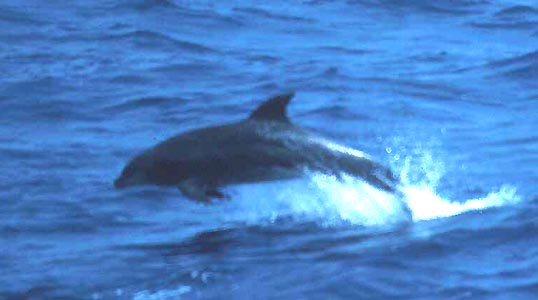 Bottlenose
Dolphin Tursiops truncatus (right) is sometimes found with tuna,
but more often on its own. These offshore populations differ genetically
from the inshore populations (to which the famous "Flipper" belonged),
but both groups indulge in dramatic leaps and flips from time to time.
Mammal people never called them "bottlenosed dolphin;" they always called
them "Tursiops" (even if the same people used common names for other
species). Bottlenose
Dolphin Tursiops truncatus (right) is sometimes found with tuna,
but more often on its own. These offshore populations differ genetically
from the inshore populations (to which the famous "Flipper" belonged),
but both groups indulge in dramatic leaps and flips from time to time.
Mammal people never called them "bottlenosed dolphin;" they always called
them "Tursiops" (even if the same people used common names for other
species). |
 Rarely
encountered was Fraser's Dolphin Lagenodelphis hosei (left).
This is a little-known dolphin found near the Equator, sometimes in groups
of thousands. Years later I was to encounter it again off the island of
Dominica in the Caribbean. Even though this is a poor shot, the "raccoon
stripe" through the face and down the flank is apparent. Rarely
encountered was Fraser's Dolphin Lagenodelphis hosei (left).
This is a little-known dolphin found near the Equator, sometimes in groups
of thousands. Years later I was to encounter it again off the island of
Dominica in the Caribbean. Even though this is a poor shot, the "raccoon
stripe" through the face and down the flank is apparent. |
 Equally
uncommon were packs of Melon-headed Whale Peponocephala electra
(right). These marauding packs churn up the sea as they move at great speed.
Together with False Killer Whale Pseudorca crassidens and pilot
whales, they are commonly called "blackfish." Blackfish are often accompanied
by seabirds; it appears that Parkinson's Petrel Procellaria parkinsoni
has
a very strong association with these small sociable whales. Equally
uncommon were packs of Melon-headed Whale Peponocephala electra
(right). These marauding packs churn up the sea as they move at great speed.
Together with False Killer Whale Pseudorca crassidens and pilot
whales, they are commonly called "blackfish." Blackfish are often accompanied
by seabirds; it appears that Parkinson's Petrel Procellaria parkinsoni
has
a very strong association with these small sociable whales. |
 Short-finned
Pilot Whale Globicephala macrorhynchus (left) occurs in small
pods or family groups. It is easily recognized by both the bulbous head
and the very broad base to the dorsal fin, even in poor light conditions. Short-finned
Pilot Whale Globicephala macrorhynchus (left) occurs in small
pods or family groups. It is easily recognized by both the bulbous head
and the very broad base to the dorsal fin, even in poor light conditions. |
 Orca
(Killer Whale) Orcinus orca (right) was only encountered a handful
of times. It must be difficult for these large predatory whales to find
enough food in the tropics, since cetaceans are scattered so far apart.
It is very different in the tropics than in, say, Monterey Bay, where upwelling
concentrates foods and congregates sea-going mammals. I expect that tropical
orcas eat a lot of fish. Orca
(Killer Whale) Orcinus orca (right) was only encountered a handful
of times. It must be difficult for these large predatory whales to find
enough food in the tropics, since cetaceans are scattered so far apart.
It is very different in the tropics than in, say, Monterey Bay, where upwelling
concentrates foods and congregates sea-going mammals. I expect that tropical
orcas eat a lot of fish. |
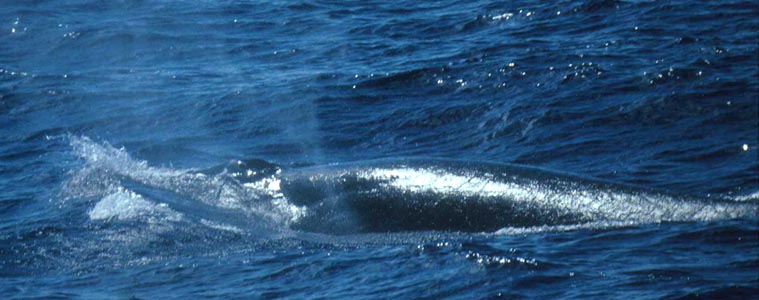 |
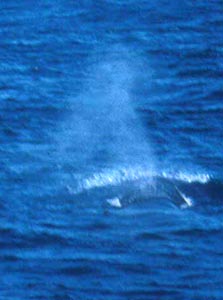 Among
large baleen whales, only the Bryde's Whale Balaenoptera edeni
(above)
was regularly encountered. "Bryde's" is a Scandinavian name, and on the
ship we pronounced it "brew-dah's" Whale. Here we see a blow (left) on
a whale headed straight way, and the other shot (above) we've just missed
the head and are starting to see the back of a very close whale. These
whales change direction randomly underwater and are hard to follow. We
always tried to get close enough to see the three rostral ridges that separates
it from the similarly sized Sei Whale
B. borealis. Among
large baleen whales, only the Bryde's Whale Balaenoptera edeni
(above)
was regularly encountered. "Bryde's" is a Scandinavian name, and on the
ship we pronounced it "brew-dah's" Whale. Here we see a blow (left) on
a whale headed straight way, and the other shot (above) we've just missed
the head and are starting to see the back of a very close whale. These
whales change direction randomly underwater and are hard to follow. We
always tried to get close enough to see the three rostral ridges that separates
it from the similarly sized Sei Whale
B. borealis. |
Other cetaceans seen offshore during the four-month cruise were Pacific
White-sided Dolphin Lagenorhynchus obliquidens (off Baja), Risso's
Dolphin (Grampus) Grampus griseus, Humpback Whale Megaptera novaeangliae,
Pygmy Killer Whale Feresa attenuata, False Killer Whale Pseudorca
crassidens, Dwarf Sperm Whale Kogia simus, Pygmy Sperm Whale
Kogia
breviceps, Goose-beaked (Cuvier's) Whale Ziphius cavirostris,
and an undescribed beaked-whale Mesoplodon sp.nov. (a species that
has been photographed and described but not yet collected; full details
are in Pitman et al. (1987) "Observations of an unidentified beaked whale
(Mesoplodon sp.) in the eastern tropical Pacific," Marine Mammal
Science 3:345-352. This is a distinctive beaked whale, with a prominent
pale grayish blaze in front of the dorsal fin, is now known as "species
A" (e.g., P. Folkens, 2000, Marine Mammals of the Eastern North Pacific:
a waterproof guide). I have details and a sketch in my field notes.
|
TO GO TO EASTERN TROPICAL PACIFIC PETRELS |